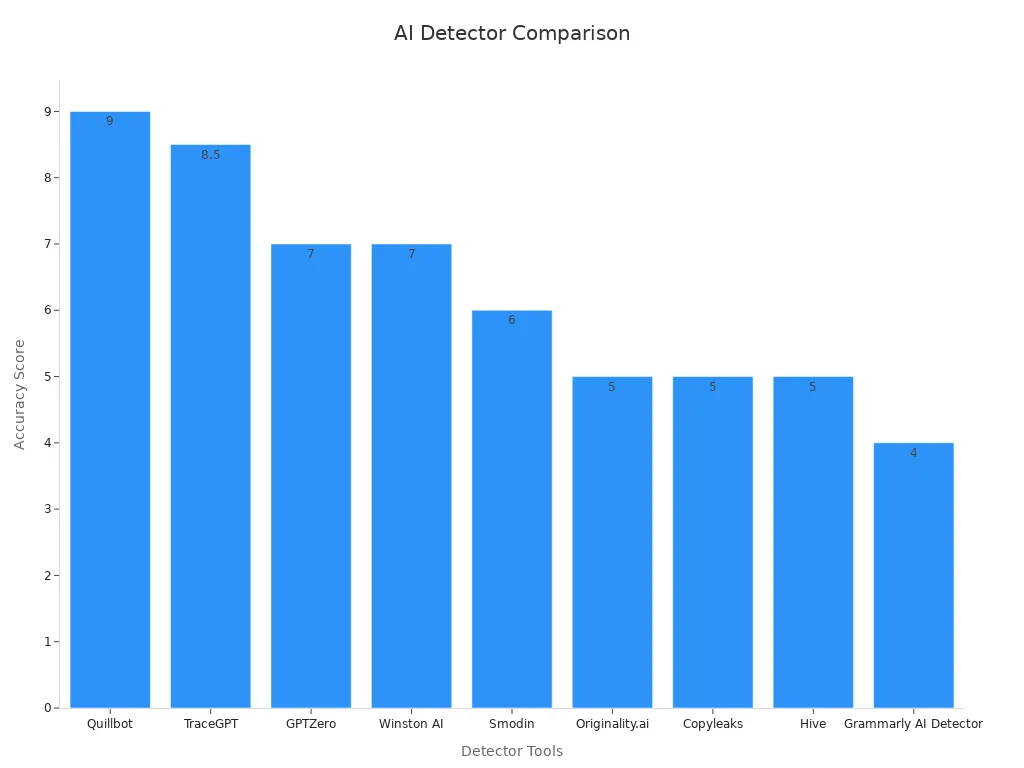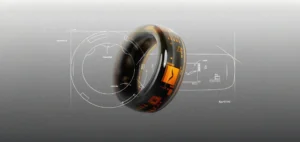
You probably see ai everywhere now. People use ai to write essays, news, and business reports. The need for good ai detector tools is growing fast. Look at these numbers:
-
Turnitin checked 200 million papers in 2023–24. 11% had a lot of ai-generated content.
-
Global student use of ai reached 86% in 2024.
-
The ai detection tool market could be worth over $1 billion by 2028.
Many industries want the best ai content detectors to keep content real. These tools help you find ai-generated content in schools, publishing, and business. The newest ai content detectors use machine learning and natural language processing to work better. Accuracy, features, ease of use, and price are most important when picking the best ai content detectors. Here’s a quick look at how experts rate these tools:

As ai gets smarter, you need ai content detection tools that can keep up. Picking the right one helps you stop misinformation and keep your work honest.
Key Takeaways
-
AI detector tools show if something is written by AI or people. They help keep work honest and original.
-
Picking the best AI detector means checking if it is correct. You should also look for helpful features. Make sure it is easy to use and not too expensive.
-
No AI detector works perfectly. Some may say people’s writing is AI by mistake. Some may not catch AI writing. So, use more than one tool and trust your own thinking.
-
AI-made content is growing very fast. This makes AI detectors important for schools, companies, and publishers.
-
Try out different tools with your own examples. This helps you find what works best for you. It also helps you stay ready as AI changes.
Quick Comparison of AI Detector Tools

Overview Table
You might wonder which ai detector tools are the best. The table below shows how the top tools do with accuracy and how they find ai. This makes it easier to see which tool could work for you.
|
AI Detector Tool |
Accuracy Score |
Detection Behavior Summary |
|---|---|---|
|
Quillbot |
9/10 |
Balanced detection; accurately identifies AI without overflagging human writing |
|
TraceGPT |
8.5/10 |
Very accurate; strong detection on AI and mixed content |
|
GPTZero |
7/10 |
Reliable for clear AI content; tends to overflag simple human writing |
|
Winston AI |
7/10 |
Decent on mixed content; heavily flags basic human writing |
|
Smodin |
6/10 |
Inconsistent; good at some AI detection but weak on human-edited AI content |
|
Originality.ai |
5/10 |
Overly aggressive; flags nearly all content as AI, including human writing |
|
Copyleaks |
5/10 |
Overflags; struggles with nuanced content |
|
Hive |
5/10 |
Overflags simple writing; performs decently on expert content, mixed results on edited AI |
|
Grammarly AI Detector |
4/10 |
Very inconsistent; flags basic human writing as AI but lets human-edited AI pass |

Key Metrics
Accuracy is important, but it is not the only thing to check. Some tools, like Quillbot and TraceGPT, do a good job. They find ai content but do not mark too much human writing as ai. Other tools, like Originality.ai and Copyleaks, are more strict. They often say even simple human writing is ai, which can be unfair.
Each tool works in its own way. For example, GPTZero looks for patterns such as perplexity and burstiness. This helps with long essays but sometimes marks short writing as ai. Copyleaks uses deep learning and gives you tags for each sentence. This is helpful for business work. Grammarly AI Detector is quick but does not always give the best results.
No tool is perfect. Many tools have trouble with human-edited ai content. Some tools miss it, while others catch it. This happens because every tool has its own rules and models. To get the best results, try a few tools and see which one works for you.
What Are AI Content Detectors
Definition
You might wonder what ai content detectors actually do. These tools help you figure out if something was written by a human or by ai. They act like content detectives, looking for clues in the writing. Here’s what experts say about them:
-
ai content detectors try to predict if content is ai-generated by checking text features.
-
They focus on where the content comes from, not just if it matches something else online.
-
You’ll see them used in schools, businesses, publishing, and even on social media.
-
They are not perfect. Sometimes, they flag human writing as ai (false positives) or miss ai content (false negatives).
-
Most experts say you should use these tools as a guide, not as final proof. It’s smart to combine them with your own judgment.
You can use ai content detectors to keep your work honest and original. They help you spot fake or copied writing, which is important in many fields.
How They Detect AI Text
So, how do these tools actually detect ai text? They use smart technology to look for patterns that ai often creates. Here’s how the process works:
-
The detector algorithms scan the writing for things like word choice, sentence length, and how often certain phrases repeat.
-
They check for predictability, called perplexity. ai writing usually follows set patterns, so it’s more predictable than human writing.
-
Burstiness is another clue. Human writing jumps around with short and long sentences, but ai tends to keep things even.
-
Some detectors use machine learning to compare your text to huge databases of both human and ai writing.
-
They may also look for odd phrases or unnatural wording that ai sometimes uses.
Tip: ai content detectors give you a probability, not a guarantee. They can help you identify generated text, but you should always double-check if something feels off.
These tools keep getting better, but they still face challenges. Sometimes, people can trick them by editing ai text. That’s why you should use more than one method for detection.
Why Use AI Detector Tools in 2025
AI Content Growth
You see ai everywhere now. In 2025, the amount of ai-generated content is exploding. You find it in articles, social media, emails, and even videos. Businesses use ai to write product descriptions, create ads, and send out newsletters. Tools like GrammarlyGO, Copy.ai, and Microsoft Copilot make it easy for anyone to produce ai-generated content in seconds.
Here’s what’s happening:
-
Ai tools help you write faster and more often. You can finish articles, social posts, and emails in minutes.
-
Companies use ai to save money and work more efficiently.
-
Ai-generated content lets you personalize messages for customers, making them feel special.
-
Marketers use ai to spot trends and improve their content.
-
The demand for ai-generated content keeps growing as more people rely on these tools.
This huge wave of ai-generated content means you need ways to check if something was made by ai or a real person. That’s where ai detector tools come in. They help you keep your work honest and original.
Risks and Benefits
Using ai detector tools brings both good things and some challenges. Let’s look at both sides:
-
Benefits:
-
You can automate checking for ai-generated content, which saves time.
-
Ai detector tools help you spot fake or copied writing.
-
They make it easier to manage documents and review drafts.
-
Businesses use them to prevent fraud and protect their brand.
-
Ai detectors help you follow rules and keep your data safe.
-
-
Risks:
-
Sometimes, ai detector tools make mistakes. They might say human writing is ai-generated content or miss real ai-generated content.
-
You need to watch out for privacy issues. Some tools may collect your data.
-
There are risks of data leaks or hackers getting into your information.
-
If you use ai-generated content without checking, you could face legal trouble.
-
Note: Experts say you should always check how reliable an ai detector tool is. Look for tools that protect your data and have a good track record. Make sure your team knows how to use them safely.
When you use ai detector tools wisely, you get the benefits and avoid most of the risks. You stay ahead in a world full of ai-generated content.
Criteria for Best AI Content Detectors
When you look for the best ai content detectors, you want tools that do more than just spot ai. You need to know how well they work, what features they offer, how easy they are to use, and if the price fits your budget. Let’s break down what matters most.
Accuracy
Accuracy is the first thing you should check. You want a tool that can tell the difference between human and ai writing. Good ai detection accuracy means the tool gets it right most of the time. But you should look at more than just one number.
-
You can check accuracy, precision, and recall.
-
Precision shows how often the tool is right when it says something is ai.
-
Recall tells you how many real ai texts the tool finds.
-
Some tools use a confusion matrix to show true positives, false positives, true negatives, and false negatives.
-
The F1 score gives you a balance between precision and recall.
If you want the best ai content detector for accuracy, look for tools that explain these numbers. This helps you trust their results and keep content authenticity high.
الميزات
The best ai content detectors come packed with features. You might see plagiarism checks, website scanning, team dashboards, or even Chrome extensions. Some tools let you upload PDFs or scan whole websites. Others highlight ai-generated sections or support many languages.
Here’s a quick look at what you might find:
|
Tool Name |
Key Features |
|---|---|
|
Plagiarism checks, website scanning, team use |
|
|
Sapling |
AI section highlights, API integration |
|
Copyleaks |
Browser extension, code detection |
Choose tools that match your needs for content originality and detection capabilities.
Usability
You want a tool that feels easy to use. The best ai content detectors have simple dashboards, fast scanning, and clear reports. Some let you copy and paste text, while others work with Google Docs or have browser add-ons. If you work with a team, look for tools with collaboration options. Good usability means you spend less time learning and more time checking content authenticity.
Pricing
Pricing can make a big difference. Some tools offer free plans with limits, while others charge monthly or yearly. For example, you might pay $4 to $14 per month for basic plans. Higher-priced tools often include more detection capabilities, better ai detection accuracy, and extra features like plagiarism checks. Always compare what you get for the price. Pick a tool that fits your budget but still gives you strong detection and originality support.
Top 10 AI Detector Tools

Originality.AI
Originality.AI is very good at finding ai-generated content. It uses smart machine learning to spot ai, even if someone tries to hide it. You can check lots of documents at once, which saves time. The tool gives you results right away.
Here’s how Originality.AI compares to other tools:
|
Feature / Metric |
Originality.AI |
Closest Competitor |
Notes |
|---|---|---|---|
|
Base Dataset Accuracy |
85% |
80% |
Compared to 11 other ai detector tools |
|
ChatGPT Content Detection Accuracy |
98.2% |
N/A |
Tested on GPT-4, Llama, Mistral |
|
Paraphrased Content Detection |
96.7% |
80% |
Handles tricky paraphrased text |
|
Adversarial Techniques Performance |
1st in 9/11 |
2nd in 1 |
Only struggled with rare bypasses |
|
GPT-3.5 and GPT-4 Content Detection |
100% |
<100% |
Outperformed Turnitin and ZeroGPT |
|
False Positive Rate |
5% |
N/A |
Keeps mistakes low |
You can use it for plagiarism checks and team work. It works with many file types and gives clear reports. The price starts at $0.01 for every 100 words.
Pros:
-
Very accurate for chatgpt content
-
Finds paraphrased and edited ai-generated content
-
Checks lots of files at once
-
Makes few mistakes
Cons:
-
Sometimes marks simple human writing as ai
-
No free version
If you want a strong ai detector tool, Originality.AI is a great choice because it is accurate and has many features.
Winston AI
Winston AI does more than just check text. It can also look at images, deepfakes, and handwritten notes. Winston AI says it is 99.98% accurate and gives a special HUMN-1 certificate to show your work is all human.
|
Feature/Metric |
Details/Value |
|---|---|
|
Detection Accuracy |
99.98% claimed |
|
Certification |
HUMN-1 for 100% human work |
|
Detection Scope |
Text, images, deepfakes, handwritten notes |
|
AI Systems Detected |
ChatGPT (GPT-4), Google Gemini, LLaMa, Claude |
|
Pricing Plans |
Free (2,000 words), Essential ($18/mo), Advanced ($29/mo), Elite ($49/mo) |
|
User Experience |
14-day free trial |
|
Limitations |
May flag human writing as AI |
You can upload files or links. Winston AI checks each sentence and gives a “Human Score.” It also checks for plagiarism and lets teams work together. There is an API, Chrome extension, and it works with learning systems.
Pros:
-
Checks text, images, and deepfakes
-
Fast checks and scans many files
-
Gives reports you can share
Cons:
-
Sometimes marks human writing as ai-generated content
-
Costs more for big projects
Winston AI is good if you need to check more than just text and want lots of features.
Copyleaks
Copyleaks is popular with schools and businesses. It checks for plagiarism and ai-generated content. You can scan many file types and use it in over 30 languages. There is a browser extension for quick checks.
Copyleaks says it is 99% accurate and only makes mistakes 0.2% of the time. Many people like its features, but some say it sometimes makes mistakes. It checks files quickly and keeps your data private.
Pros:
-
Very accurate and makes few mistakes
-
Good at checking for plagiarism and privacy
Cons:
-
Some users say it sometimes makes mistakes
-
Can be hard to use at first
Copyleaks is a strong choice for schools and publishers who need both ai detection and plagiarism checks.
GPTZero
GPTZero is a well-known ai detector tool. It is easy to use and gives fast results. GPTZero works well with essays that mix human and ai writing.
|
Performance Metric |
GPTZero Result |
Description/Context |
|---|---|---|
|
Accuracy Rate (AI vs Human) |
99% |
Correctly classifies ai-generated text 99 out of 100 times. |
|
Accuracy Rate (Mixed Content) |
96.5% |
Handles essays with both human and ai writing. |
|
False Positive Rate |
≤ 1% |
Keeps mistakes low. |
|
Benchmarking Scope |
Large datasets |
Tested on Claude, Llama, Gemini, and more. |
|
Independent Validation |
Yes |
Reviewed by Penn State and top tech sites. |
You can check files in real time and scan many at once. There is a free plan with limits and paid plans for more features.
Pros:
-
Very accurate and makes few mistakes
-
Easy to use for chatgpt content
Cons:
-
Sometimes marks simple human writing as ai
-
Free plan has word limits
GPTZero is a good pick if you want fast, easy ai detection.
ZeroGPT
ZeroGPT is another good tool for finding ai-generated content. It is 96% accurate for chatgpt content and 88% for rephrased text. You can use it with many languages and file types.
ZeroGPT has a free plan for small jobs and paid plans for bigger needs. It shows which parts of your document are ai-generated and gives a score.
Pros:
-
Good accuracy for chatgpt content
-
Works with many languages and formats
-
Has a free plan
Cons:
-
Not as good with heavily edited ai-generated content
-
Some users say results can change
ZeroGPT is a simple and affordable tool for everyday ai checks.
Turnitin
Turnitin is famous for checking plagiarism and now finds ai-generated content too. Schools trust Turnitin to check student papers for ai. It looks for ai patterns and compares work to big databases.
-
Many schools use Turnitin to find papers with lots of ai-generated text.
-
Some students admit to using ai, while others do not, so careful review is needed.
-
Turnitin helps manage ai use and supports honesty in schoolwork.
You get detailed reports and can scan many files at once. It works with school systems and is sold to schools, not individuals.
Pros:
-
Trusted by teachers everywhere
-
Checks for plagiarism and ai
-
Works with school platforms
Cons:
-
Can mark real writing help as ai-generated content
-
Not for single users
Turnitin is best for schools that need strong, large-scale ai detection.
Surfer SEO
Surfer SEO is more than an ai detector. It helps you make your website better and checks for ai-generated content. Surfer SEO keeps your site original and helps with search rankings.
You can check content in real time, scan for plagiarism, and scan many files. It works with Google Docs and has team dashboards. Prices start at $59 per month.
Pros:
-
Combines SEO and ai detection
-
Good for marketers and website owners
-
Easy to use with other tools
Cons:
-
Costs more than basic ai detector tools
-
Focuses more on SEO than deep ai checks
Surfer SEO is great if you want to improve your website and keep content original.
Content at Scale AI Detector
Content at Scale AI Detector is good for checking lots of content fast. It is great for big teams and agencies. The tool uses both ai and human review for better results.
-
It is 98% accurate, better than many free tools.
-
Scans lots of content quickly and gives fast feedback.
-
Helps you avoid Google penalties by keeping content original.
You get an easy interface, real-time feedback, and good support. There are training and custom options too.
Pros:
-
High accuracy and fast scanning
-
Uses ai and human review
-
Good support and training
Cons:
-
Not free; best for big teams
-
May be too much for small jobs
Content at Scale AI Detector is a top choice if you need to check lots of content and want strong results.
Sapling AI Detector
Sapling AI Detector is flexible and works with many tools. You can use it with Google Docs, Slack, or set up automatic checks with its API. Sapling lets you paste text, upload files, or use a Chrome extension.
|
Aspect |
Details |
|---|---|
|
Detection Rate |
|
|
False Positive Rate |
Under 3% in internal tests |
|
Detection Method |
Dual-detection Transformer model |
|
Integration Capabilities |
API access for workflow automation |
|
User Input Methods |
Paste, upload, Chrome extension |
|
Interface |
User-friendly, shows sentence-level analysis |
Sapling checks files in real time and can scan many at once. You get links to share results and updates for new ai models. The Pro plan gives API access for big jobs.
Pros:
-
Works with many tools and automates checks
-
Very accurate and makes few mistakes
-
Easy to use
Cons:
-
Sometimes marks human text as ai-generated content
-
Some features need a paid plan
Sapling AI Detector is a smart pick if you want to automate ai checks and make your work easier.
Writer AI Content Detector
Writer AI Content Detector helps you keep your writing original. You can use it for school, business, or marketing. It checks for ai-generated content in real time and can scan lots of files.
People worry about ai, so a good detector is important. Writer AI Content Detector says it is up to 99% accurate and makes less than 2% mistakes. You can change settings, connect it to other tools, and use a simple interface.
Pros:
-
Very accurate and makes few mistakes
-
Can be changed for different needs
-
Checks for plagiarism and helps with SEO
Cons:
-
May not find every new ai model
-
Some features need a paid plan
Writer AI Content Detector is a good choice if you want to protect your brand and keep your writing original.
How to Choose the Best AI Detector Tool
Assessing Your Needs
Before you pick any tools, you need to know what you want to achieve. Are you a teacher looking for an ai content detector for students? Maybe you run a business and want to keep your brand safe. Start by thinking about your main goals. Do you want to detect ai text in essays, business reports, or website articles? Make a list of your top needs.
Here’s a table to help you break down your evaluation:
|
Evaluation Stage / Category |
What to Check For |
Why It Matters |
|---|---|---|
|
Does the tool spot ai and human writing correctly? |
Keeps your results fair and useful |
|
|
Task Performance |
Can it handle your type of content? |
Matches your real-world use |
|
Safety Profile |
Does it avoid risky or unsafe content? |
Protects your data and users |
|
Robustness |
Can it handle tricky or edited ai text? |
Works even with hard-to-detect cases |
|
Fluency & Coherence |
Does it read like natural language? |
Helps you trust the results |
You can also set up your own scoring system. For example, rate how well a tool can detect ai text from 1 to 5. This helps you compare different options side by side.
Comparing Features
Now, look at what each tool offers. Some tools have extra features that make your job easier. You might want real-time analytics, team dashboards, or even self-healing automation. Here’s a quick table to compare:
|
Feature |
Tool A |
Tool B |
Tool C |
|---|---|---|---|
|
Real-Time Analytics |
✅ |
❌ |
✅ |
|
Self-Healing Automation |
✅ |
✅ |
❌ |
|
Integration Options |
Google Docs |
Slack, API |
Chrome Ext |
|
Pricing Model |
Free/Paid |
Paid |
مجاناً |
Tip: Make sure the tool fits your workflow. If you use Google Docs or Slack, pick a tool that connects easily. Also, check if the pricing matches your budget.
You should also think about how easy the tool is to use. If your team needs training, pick something simple. Some tools even help you prioritize which content to check first, using ai to spot risky areas.
Testing to Detect AI Text
You should always test before you decide. Try each tool with real samples. Use essays, business emails, and even ai-generated stories. Good testing means you check both human and ai text. Include paraphrased or translated samples to see if the tool can still detect ai text.
Here’s a simple checklist for your ai text check:
-
Use a mix of human and ai-generated samples.
-
Check the confusion matrix: true positives, false positives, true negatives, and false negatives.
-
Look at precision and accuracy to see how well the tool works.
-
Do a quick error analysis to spot any patterns or mistakes.
Note: No tool is perfect. Some tools do better with certain types of content. Keep testing as ai changes and gets smarter.
If you follow these steps, you will find the best tools for your needs. You will feel confident every time you detect ai text in your work.
Limitations of AI Content Detectors
False Positives
When you use ai to check for ai-generated content, you might run into false positives. This means the tool says something is ai-generated when a real person wrote it. False positives can cause big problems. You might wrongly accuse someone of cheating or copying. This can hurt trust and make people feel stressed.
Different ai tools have different rates of false positives. Take a look at this table:
|
Tool Name |
False Positive Rate |
Notes |
|---|---|---|
|
Turnitin |
0.51% |
About 1 in 200 academic papers |
|
GPTZero |
2.01% |
Higher than claimed in some tests |
|
Copyleaks |
0.2% |
Very low, but not zero |
|
Pangram |
0.004% |
Very rare, but varies by content type |
Some types of writing, like recipes or poetry, get flagged more often. These texts are short or have odd patterns, so ai tools struggle with them. You can see how these rates compare in the chart below:

Note: False positives are more harmful than missing some ai-generated content. They can damage reputations and trust.
Developers try to fix this by testing with lots of different texts. They use both numbers and real people to check results. Still, no tool is perfect. You should always double-check before making a big decision.
Evolving AI Models
Ai keeps changing fast. New models come out all the time. This makes it hard for ai tools to keep up. Sometimes, the tools miss new tricks that ai uses to make ai-generated content look more human.
Here are some reasons why this happens:
-
Ai models change and get better, so old tools may not spot new ai-generated content.
-
Sometimes, ai makes mistakes called “hallucinations.” These can fool both people and tools.
-
Data problems, like missing or messy info, make detection harder.
-
Hardware or software issues can slow down or break the tools.
-
Hackers can attack ai systems and change how they work.
You can see more challenges in this table:
|
Challenge Area |
Example Problems |
|---|---|
|
Data Sets |
Not enough good data, bias, or errors |
|
Algorithms |
Too simple or too complex, overfitting |
|
Hardware/Software |
Not enough power or storage, bugs |
|
Security |
Attacks or leaks that change results |
Tip: Even the best ai tools need updates and human review. You should not trust any tool 100% for ai-generated content.
As ai gets smarter, you need to stay alert. Use more than one tool if you can. Always use your own judgment when checking for ai-generated content.
You’ve seen that no AI detector tool is perfect. Some tools catch AI writing most of the time, but others miss it or flag real writing by mistake. Check out this quick table:
|
Study/Source |
Key Findings |
Accuracy |
False Positive Rate |
|---|---|---|---|
|
Cooperman & Brandão |
Detectors spot AI ~63% |
~63% |
24.5% – 25% |
|
OpenAI Classifier |
Low success, discontinued |
26% |
N/A |
Pick a tool that fits your needs. Try a few, compare results, and remember—AI keeps changing fast. Stay curious and keep learning as new tools and trends appear!
التعليمات
What is an AI detector tool?
An AI detector tool helps you figure out if a piece of writing came from a human or an AI. You just paste your text, and the tool gives you a quick answer.
Can AI detectors spot all AI-generated content?
No, they can’t catch everything. Some AI writing looks very real. You might need to use more than one tool or check the text yourself.
Are AI detector tools free to use?
Some tools offer free versions with limits. Others ask you to pay for more features or bigger checks. Always check the pricing before you start.
Why do AI detectors sometimes make mistakes?
AI detectors look for patterns. Sometimes, they get confused by simple or unusual writing. You might see false positives or miss real AI text.
How can I get the best results from an AI detector?
Try using a few different tools. Check both short and long texts. If something feels off, trust your gut and review it yourself.




